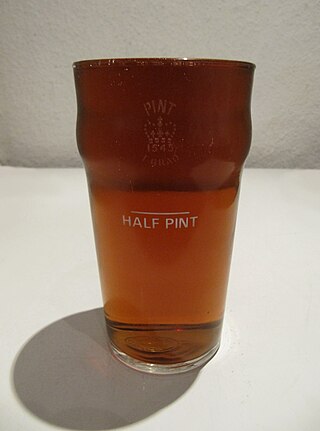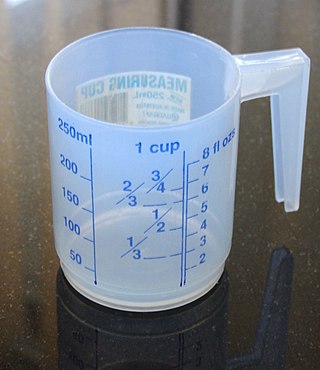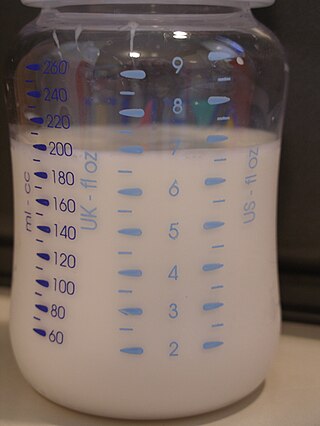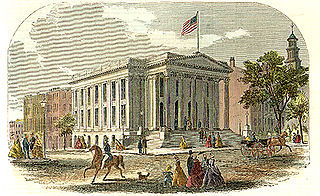
The imperial system of units, imperial system or imperial units is the system of units first defined in the British Weights and Measures Act 1824 and continued to be developed through a series of Weights and Measures Acts and amendments.

The litre or liter is a metric unit of volume. It is equal to 1 cubic decimetre (dm3), 1000 cubic centimetres (cm3) or 0.001 cubic metres (m3). A cubic decimetre occupies a volume of 10 cm × 10 cm × 10 cm and is thus equal to one-thousandth of a cubic metre.

Metrication or metrification is the act or process of converting to the metric system of measurement. All over the world, countries have transitioned from local and traditional units of measurement to the metric system. This process began in France during the 1790s, and has persistently advanced over two centuries, accumulating into 95% of the world officially only using the modern metric system. Nonetheless, this also highlights that certain countries and sectors are either still transitioning or have chosen not to fully adopt the metric system.

The pound or pound-mass is a unit of mass used in both the British imperial and United States customary systems of measurement. Various definitions have been used; the most common today is the international avoirdupois pound, which is legally defined as exactly 0.45359237 kilograms, and which is divided into 16 avoirdupois ounces. The international standard symbol for the avoirdupois pound is lb; an alternative symbol is lbm, #, and ℔ or ″̶.

United States customary units form a system of measurement units commonly used in the United States and most U.S. territories, since being standardized and adopted in 1832. The United States customary system developed from English units that were in use in the British Empire before the U.S. became an independent country. The United Kingdom's system of measures was overhauled in 1824 to create the imperial system, which was officially adopted in 1826, changing the definitions of some of its units. Consequently, while many U.S. units are essentially similar to their imperial counterparts, there are noticeable differences between the systems.

In recipes, quantities of ingredients may be specified by mass, by volume, or by count.

The pint is a unit of volume or capacity in both the imperial and United States customary measurement systems. In both of those systems it is traditionally one eighth of a gallon. The British imperial pint is about 20% larger than the American pint because the two systems are defined differently. Almost all other countries have standardized on the metric system, so although some of them still also have traditional units called pints, the volume varies by regional custom.

Metrication is the process of introducing the International System of Units, also known as SI units or the metric system, to replace a jurisdiction's traditional measuring units. U.S. customary units have been defined in terms of metric units since the 19th century, and the SI has been the "preferred system of weights and measures for United States trade and commerce" since 1975 according to United States law. However, conversion was not mandatory and many industries chose not to convert, and U.S. customary units remain in common use in many industries as well as in governmental use. There is government policy and metric (SI) program to implement and assist with metrication, however there is major social resistance for further metrication.
Mesures usuelles were a French system of measurement introduced by French Emperor Napoleon I in 1812 to act as compromise between the metric system and traditional measurements. The system was restricted to use in the retail industry and continued in use until 1840, when the laws of measurement from 1795 and 1799 were reinstituted.
A system of units of measurement, also known as a system of units or system of measurement, is a collection of units of measurement and rules relating them to each other. Systems of measurement have historically been important, regulated and defined for the purposes of science and commerce. Instances in use include the International System of Units or SI, the British imperial system, and the United States customary system.

The UK Metric Association, or UKMA, is an advocacy group in the United Kingdom that argues for completion of metrication in the United Kingdom and advocates the use of the metric system among the general public in the UK.

Metrication in Canada began in 1970 and ceased in 1985. While Canada has converted to the metric system for many purposes, there is still significant use of non-metric units and standards in many sectors of the Canadian economy and everyday life today. This is mainly due to historical ties with the United Kingdom, the traditional use of the imperial system of measurement in Canada, proximity to the United States, and strong public opposition to metrication during the transition period.

Metrication in Australia effectively began in 1966 with the conversion to decimal currency under the auspices of the Decimal Currency Board. The conversion of measurements—metrication—commenced subsequently in 1971, under the direction of the Metric Conversion Board and actively proceeded until the Board was disbanded in 1981.

Metrication, the process of introducing the metric system of measurement in place of imperial units, has made steady progress in the United Kingdom since the mid-20th century but today remains equivocal and varies by context. Most of government, industry, commerce, and scientific research use the metric system. Imperial units are officially used to specify journey distances, vehicle speeds and the sizes of returnable milk containers, beer and cider glasses, fresh milk is often still sold in multiples of pints, with the metric equivalent also marked, and precious metals are sold by the troy ounce. Metric units must be used when selling other packaged or loose goods, and imperial units can stand alongside the metric units, but it cannot stand out more than the metric units. Imperial units are also often used to describe body measurements and vehicle fuel economy. The national curriculum requires metric units and imperial units that still remain in common usage to be taught in state schools.

The cup is a cooking measure of volume, commonly associated with cooking and serving sizes. In the US, it is traditionally equal to one-half US pint (236.6 ml). Because actual drinking cups may differ greatly from the size of this unit, standard measuring cups may be used, with a metric cup being 250 millilitres.

Metrication in the Republic of Ireland happened mostly in the 20th century and was officially completed in 2005, with a few exceptions.

Both the British imperial measurement system and United States customary systems of measurement derive from earlier English unit systems used prior to 1824 that were the result of a combination of the local Anglo-Saxon units inherited from Germanic tribes and Roman units.
The Weights and Measures Act is a Canadian law governing the units of measurements used in Canada.

A unit of measurement, or unit of measure, is a definite magnitude of a quantity, defined and adopted by convention or by law, that is used as a standard for measurement of the same kind of quantity. Any other quantity of that kind can be expressed as a multiple of the unit of measurement.

The imperial and US customary measurement systems are both derived from an earlier English system of measurement which in turn can be traced back to Ancient Roman units of measurement, and Carolingian and Saxon units of measure.















